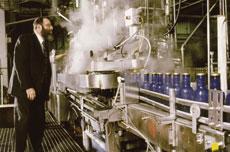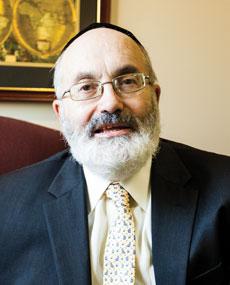
An OU mashgiach offers kosher supervision to a local factory. The OU operates in 50 states and in 80 countries.(Courtesy of the OU)
Kosher products started finding their way into the American marketplace around 1918, according to kosherquest.org. In 1924, the Union of Orthodox Jewish Congregations of America (OU), which had been established in 1892, entered the kashrut industry and appointed Abraham Goldstein (a chemist who had been instrumental in convincing American companies to become certified kosher) as its first kosher director, a role he held until 1935.
At that time, Goldstein, according to kosher quest.org, determined that diversity (as opposed to a monopoly) was better for the industry. So he launched the O/K. Over the last 50 years of what industry experts call the “food revolution” — the preparation of more and more foodstuffs outside the home — the OU and the O/K have been instrumental in ensuring kosher products are on the shelves.
As the demand rose — and continues to rise — other organizations have come into the market, too, including the local Star-K, which, although founded in 1947, stepped up its game in the 1970s.
Keeping kosher is complicated. Which certifications (heksherim) can you trust? Does every product need a heksher? What is the difference between a local va’ad hakashrut and the symbols we see on products manufactured throughout the world?
A high-riser in the heart of Manhattan is a first stop for finding these answers. Three floors and hundreds of rabbis and other staff comprise the OU headquarters, located at 11 Broadway.
“We’re very much controlled from the headquarters,” said Rabbi Moshe Elefant, chief operating officer of the Kashrut Department, explaining that for a company to certify products in all 50 states and in more than 80 countries, it has to be consistent, “there has to be one OU for the whole world.”
The management philosophy, the hierarchy, works like this: Every account under the OU has a mashgiach, a person who inspects and supervises the kosher status of a kosher establishment. Each mashgiach reports to a rabbinic coordinator (RC). In the real world, explained Rabbi Elefant, RCs would be called account executives. The RCs are divided by industry and become experts in their niche — flavors, wines, meats, baked good, beverages, oil, etc.
Each RC reports to a group leader. The purpose of the group leader is for the mashgichim to have someone to be available when the RC is not and to manage, guide and advise the RCs. The group leaders report to OU Chief Executive Officer Rabbi Menachem Genack and to Rabbi Elefant. Rabbis Yisroel Belsky and Herschel Schachter serve as the OU’s rabbinic advisers, meeting weekly to discuss and answer the dozens of questions that arrive to headquarters from the field.
The questions and answers are archived in an intricate computer system, able to be accessed if that question — or a similar one — is posed again.
“I am the recorder of policy,” said Rabbi Eli Gersten with pride.
Each week, Rabbi Gersten sits at the feet of these rabbinic leaders, posing complicated questions and taking notes on the answers. He then transcribes his notes into the computer system.
“If a question comes up, people come to me first,” he said, pulling out his handwritten note for a particular Thursday. A first dozen questions are in red — those are ones that must get answered. Farther down the page is a handful of black-inked notes. These are questions for which it would be nice to get the answers, but they could wait until the following week.
“Part of [my job] is that we also sometimes get different answers from Rabbi Belsky and Rabbi Schachter. We have to make peace to know how to proceed. … Usually we can come to some sort of compromise,” said Rabbi Gersten. “It’s very rare that we need to go to Rabbi Genack. He’s the arbiter. He’s the office policy of how the OU runs when there’s a disagreement between Rabbi Belsky and Rabbi Schachter.”
The OU’s total enterprise is upward of 1,000 people.
The local va’ad, the Star-K, is not too dissimilar, just smaller. Dr. Avrom Pollak serves as president and handles the administrative sides of the business. Rabbi Moshe Heinemann acts as the rabbinic adm-inistrator. There are nine or 10 rabbinic advisers in the office, located on Slade Avenue, and then several dozen rabbinic coordinators in the field reporting back. The masgichim report to the coordinators.

